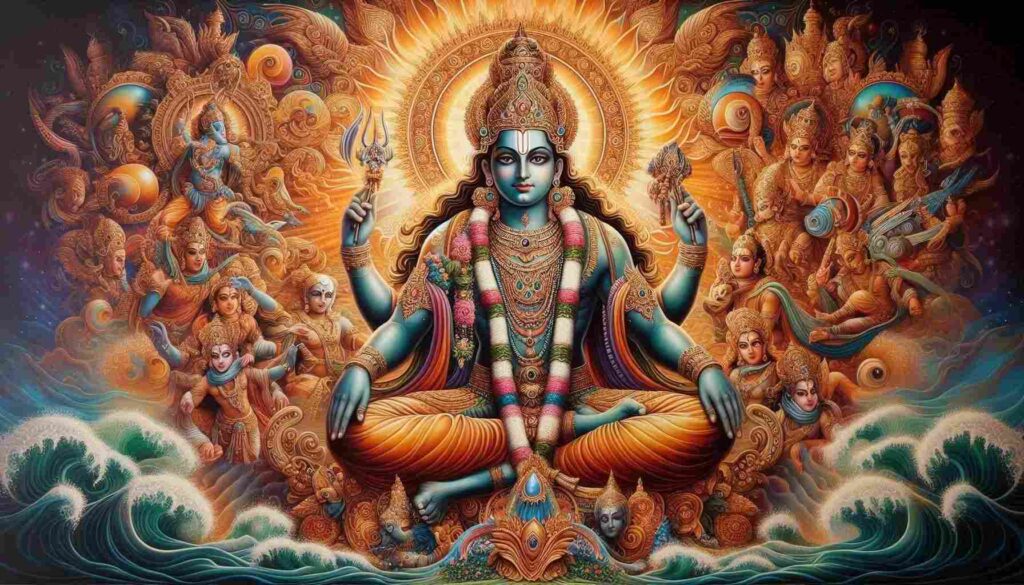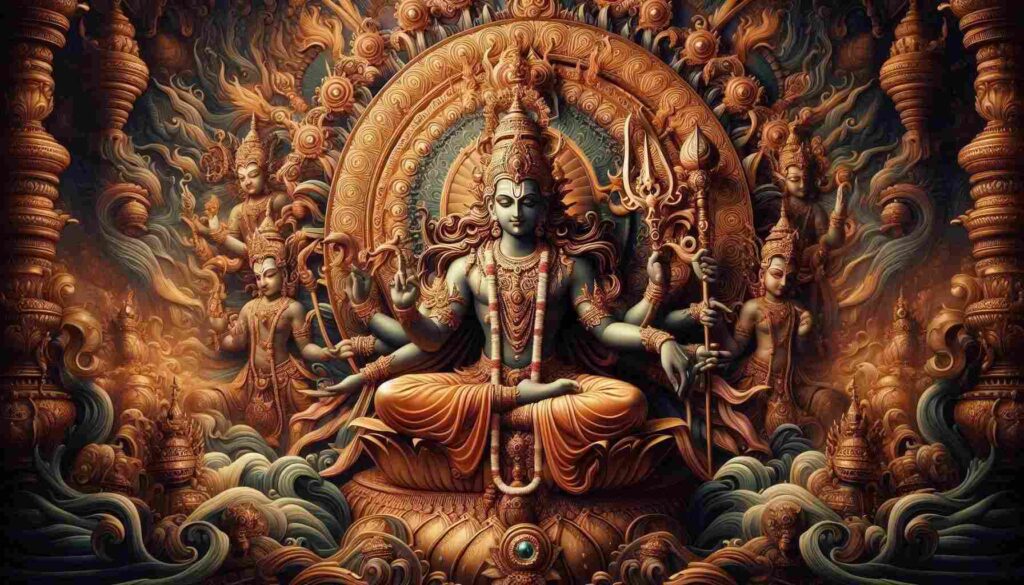
Vishvarupa: The Cosmic Form of Lord Vishnu
Introduction to Vishvarupa
Vishvarupa, or the universal form of Lord Vishnu, is one of the most awe-inspiring and mystical representations in Hindu philosophy. Known as the “Cosmic Form,” Vishvarupa is an embodiment of the entire universe, illustrating the omnipresence and omnipotence of the Supreme Being. This form was famously revealed to Arjuna during the Bhagavad Gita discourse in the Mahabharata—a moment that encapsulates the divine power, grandeur, and boundless nature of Vishnu.
Read More About Hindu Philosophy
Vishvarupa is a powerful reminder that the divine exists in all things, visible and invisible, tangible and intangible. It represents the interconnectedness of creation, where the divine manifests not only in the heavens but also within every living being, every element, and every phenomenon in the cosmos.
The Symbolism of Vishvarupa

The word “Vishvarupa” translates to “universal form” or “all forms.” It depicts Vishnu’s ability to pervade the entire universe. The form is often described in great detail in various Hindu texts, where Vishvarupa contains the heavens, the earth, the underworld, and everything in between. It represents both creation and destruction, signifying the cyclical nature of existence in Hindu cosmology.
In the Bhagavad Gita (Chapter 11), when Krishna reveals his Vishvarupa to Arjuna, it is described as a form with countless faces, eyes, mouths, and limbs. It is adorned with infinite divine weapons, garlands, and ornaments, and shines like thousands of suns. Vishvarupa not only encompasses all living beings but also the natural forces, planets, stars, and time itself. In this form, Vishnu is not just a protector or preserver but also the creator and destroyer—an embodiment of the entire cosmos and its dynamic processes.
The revelation of Vishvarupa demonstrates several key themes in Hinduism:
- Oneness with the Universe: Everything in existence is interconnected and part of a greater divine plan.
- Omnipresence of the Divine: God is present in every particle of creation, within both the macrocosmic (the universe) and microcosmic (individual beings) realms.
- Cycle of Creation and Destruction: The universe is in a constant state of flux, moving through cycles of creation, sustenance, and dissolution, all under the divine will of Vishnu.
Vishvarupa in the Bhagavad Gita

The most well-known account of Vishvarupa occurs in the Bhagavad Gita, during the Kurukshetra War. Arjuna, the great warrior prince, is hesitant to fight against his kin and is conflicted about the nature of duty (dharma). In response, Krishna, serving as Arjuna’s charioteer, delivers a divine discourse on life, death, duty, and the soul.
At Arjuna’s request to see Krishna’s divine form, Krishna reveals his Vishvarupa—the universal form that encompasses the entire cosmos. The form is described in vivid and terrifying detail, with Krishna revealing countless faces, arms, and eyes. In this form, Arjuna sees both the creation and destruction of the universe. The Bhagavad Gita describes the experience as both magnificent and terrifying, overwhelming Arjuna with awe and fear.
Here are some significant verses from the Bhagavad Gita that describe Vishvarupa:
- Bhagavad Gita 11:10-11:
“Arjuna saw in that cosmic form of Krishna countless faces, eyes, and wondrous sights, all divine, wearing celestial garlands and robes, and resplendent with heavenly fragrances and weapons.” - Bhagavad Gita 11:32:
“I am time, the great destroyer of the world, and I have come to engage all people. With the exception of you [the Pandavas], all soldiers here on both sides will be slain.”
This revelation makes Arjuna realize that Krishna is not merely his friend or a mortal being but the Supreme Lord who controls the fate of the entire universe. Vishvarupa illustrates the incomprehensible magnitude of the divine, stretching beyond any single form or deity.
The Philosophical Significance of Vishvarupa

Vishvarupa plays a crucial role in conveying the core philosophical teachings of Hinduism, especially those related to Advaita Vedanta and the concept of Brahman (the ultimate, formless reality). In this philosophy, the universe and all its diverse forms are manifestations of one underlying divine essence. Vishvarupa, in this context, is the visual embodiment of this truth—the unity of all existence under one divine consciousness.
By revealing Vishvarupa, Krishna affirms the idea that the divine cannot be confined to one specific form, deity, or incarnation. Instead, the divine pervades all of creation, expressing itself in myriad forms. This non-dualistic perspective is a cornerstone of Hindu spirituality, promoting the belief that all paths, all beings, and all aspects of the universe are part of the same divine reality.
Furthermore, Vishvarupa reinforces the cyclical nature of time and existence in Hindu cosmology. In this form, Vishnu is the creator, preserver, and destroyer, embodying the cycle of birth, death, and rebirth (samsara). This cycle is not viewed as a linear process but as an eternal, continuous movement guided by divine law (dharma).
Vishvarupa in Hindu Art and Iconography
The depiction of Vishvarupa in Hindu art is a challenging yet fascinating endeavor. Artists often portray Vishvarupa as a towering figure with numerous heads, arms, and eyes, symbolizing the boundless, multifaceted nature of the divine. Some of the most iconic depictions include:
- Infinite Faces and Limbs: Symbolizing the countless manifestations of the divine in all living beings, elements of nature, and cosmic forces.
- Weapons and Ornaments: Adorned with divine weapons like the Sudarshana Chakra (discus), the Panchajanya (conch), and other tools that represent Vishnu’s role as the preserver and destroyer of evil.
- Cosmic Imagery: Many artists include imagery of the sun, moon, stars, and planets within the body of Vishvarupa, reinforcing the notion that all celestial bodies are contained within the divine form.
- Multiple Perspectives: Vishvarupa is often depicted with multiple faces, each reflecting different emotions or aspects of the divine. This illustrates the multifaceted nature of God, who can embody love, compassion, wrath, and destruction simultaneously.
One of the most famous artistic representations of Vishvarupa can be found in the murals of the Srirangam Temple in Tamil Nadu, where the cosmic form of Vishnu is illustrated with great detail and symbolism.
Festivals and Rituals Dedicated to Vishvarupa
Though there are no specific festivals dedicated exclusively to Vishvarupa, its significance is celebrated during major Vishnu festivals, particularly in temples dedicated to Krishna and Vishnu. The festival of Krishna Janmashtami—the birth of Krishna—often includes readings from the Bhagavad Gita, recounting the moment of Vishvarupa’s revelation.
Additionally, the celebration of Ekadashi—a twice-monthly fasting day in honor of Vishnu—offers devotees a time to meditate on the universal form of Vishnu and its meaning in their spiritual journey. Temples across India may display visual depictions or conduct sermons that explore the themes of Vishvarupa during these auspicious times.
The Legacy of Vishvarupa in Modern Hinduism
In modern Hinduism, Vishvarupa continues to inspire spiritual seekers. Its depiction in temples, literature, and art serves as a reminder of the vastness of the universe and the divine presence within every aspect of life. The story of Arjuna’s vision resonates with those striving to understand their place in the cosmos and their relationship with the divine.
Spiritual teachers often reference Vishvarupa as a metaphor for achieving a broader, more expansive perspective on life. Just as Arjuna was able to see beyond his immediate concerns and comprehend the vastness of Krishna’s cosmic form, modern spiritual teachings encourage individuals to look beyond their personal challenges and recognize the interconnectedness of all existence.
Vishvarupa in Global Popular Culture
Vishvarupa’s depiction is not limited to religious art; it has made its way into global popular culture, inspiring countless works of fiction, fantasy art, and philosophical discussions. The idea of a “cosmic being” who encompasses the entire universe has been explored in modern literature, films, and video games, often drawing direct inspiration from the concept of Vishvarupa.
Some contemporary artists have adapted the theme of Vishvarupa to express the vastness of human potential, the interconnectedness of life, and the divine presence in all things. As a symbol, Vishvarupa transcends cultural and religious boundaries, becoming a universal representation of the cosmos itself.
Conclusion: The Eternal Significance of Vishvarupa
Vishvarupa is not just a form; it is a concept that encapsulates the essence of Hindu spirituality. It represents the ultimate truth that all existence is interconnected and that the divine is present in every aspect of life. The story of Krishna revealing Vishvarupa to Arjuna continues to inspire devotion, art, and philosophy, reminding humanity of the infinite nature of the universe and the divine presence that sustains it.
In Vishvarupa,


